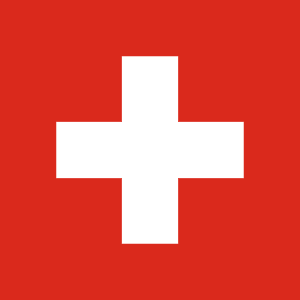
| Colors | HEX Code | RGB | CMYK |
|---|---|---|---|
| Red | #C4281D | 196, 40, 29 | 0, 80, 85, 23 |
| White | #FFFFFF | 255, 255, 255 | 0, 0, 0, 0 |
The Swiss flag is made of a red square with a white cross in the middle. The square shape was adopted because the coats of arms were square-shaped at the time the flag was adopted. It is the only flag other than the Vatican that has a square shape, which makes it distinctive from other flags.
Meaning of the Swiss Flag
Switzerland has been deeply rooted in Christianity, therefore, the white cross on the Swiss flag symbolizes Christianity. It is linked to the Roman Catholic and Protestant Reformation movements. The meaning of the red color in the Swiss flag is not agreed upon. Some say it represents the blood of Christ, while others say it is taken from the Bernese Flag. Today, the Swiss flag is a symbol of peace, security, and equality, since Switzerland is a neutral country that does not participate in wars.
History of the Swiss Flag
The Swiss flag started with the white cross used by the Swiss soldiers in the battle of Laupen in 1339. The white cross sewn on the chain mail of the soldiers was used to distinguish them from other troops on the battlefield. Later, the white cross became a symbol used on weapons and banners of Swiss soldiers. Then the Helvetic Republic was established in 1798, so Napoleon Bonaparte issued a decree that Switzerland should have a tri-colored flag of red, green, and yellow. That was the first official flag of Switzerland.
However, after the collapse of the Helvetic Republic, the flag was no longer in use. Switzerland then became a confederation, and in 1840, the current design of the flag was adopted. It was officially hoisted in 1848 as the national emblem of the country. The Swiss flag is sometimes confused with the Red Cross flag, however, the colors are reversed in the Red Cross flag.